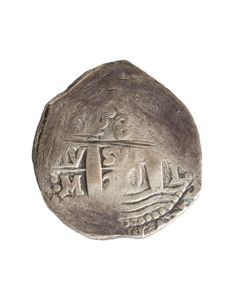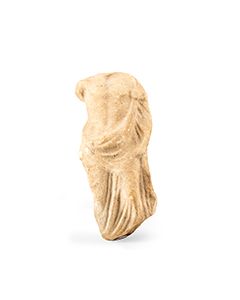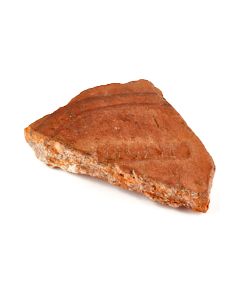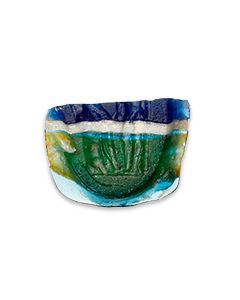Sold antiquities
Archive of sold antiquities
All artefacts sold in our gallery are fully documented in our online archive and database. Being a specialist ancient art dealer, preserving also the more recent history of each and every piece sold in our shop is at our heart. That is particularly useful for artefacts that changed owners in the meantime. Information that may have been lost in the process can be easily restored from our archives. Please do not hesitate to contact us if you need further information about ancient items that have been sold in our gallery. We can help you with reconstructing the history of ownership for those items. All information about our customers will be kept confidential, of course.-
 Roman glass bracelet with beautiful decoration
Roman glass bracelet with beautiful decorationThe small bangle from the 4th century is decorated with polychrome glass layers on the outside. Made in the Eastern Mediterranean.
Price: on request Decorated ancient glass bracelet
Decorated ancient glass braceletThe bangle is made of turquoise glass and beautifully decorated in white and blue. A product from the eastern Mediterranean coast.
Price: on request Etruscan scarab with athletes
Etruscan scarab with athletesMiniature work of art of the highest quality, a flagship of late Etruscan glyptics. Made of shimmering orange carnelian. Published several times and with provenance dating back to the 19th century.
Price: on request Large Hellenistic clay figurine of a standing woman
Large Hellenistic clay figurine of a standing womanExcellently preserved example of fine Hellenistic artistry. Ex Bonhams, ex renowned Joseph Klein collection, New York, USA.
Price: on request Elamite horse rhyton
Elamite horse rhytonFascinating clay vessel in the shape of a horse from the Neo-Elamite period, around 700 BC. A TL analysis report is included with the piece.
Price: on request Square bottle of thick glass
Square bottle of thick glassSmall ancient glass flask, like they are found along the old trade routes of the Islamic world. Such bottles were used around 1000 years ago to transport precious oils and other liquids.
Price: on request Bird brooch from Roman Britain
Bird brooch from Roman BritainNice fibula in the shape of a stylized water bird. A find from Britain and probably also a local Roman provincial production.
Price: on request Roman crossbow brooch
Roman crossbow broochVery nice specimen with niello inlays and remains of the original gilding. From the mid 4th century AD. Published in two stardard works on ancient fibulae.
Price: on request Roman plate brooch
Roman plate broochOval bronze brooch with a setting for a glass insert. From the Roman imperial period. Published in two stardard works on ancient brooches by Richard Hattatt.
Price: on request Mesopotamian stone vessel
Mesopotamian stone vesselHeavy and high quality vessel from Bronze Age of Mesopotamia, reminescent of similar Egyptian stone vessels. Ex Christie's.
Price: on request Roman intaglio with bull
Roman intaglio with bullPrime example of Roman glass pastes with a perfectly sharp depiction of a bull ready to fight.
Price: on request Roman intaglio with fantastic beast
Roman intaglio with fantastic beastThe dark glass paste depicts an animal composed of two front parts. From the Professor Brosch collection of ancient glass pastes.
Price: on request Sword from the European Bronze Age
Sword from the European Bronze AgeWonderfully preserved bronze weapon from the Late Bronze Age around 1200 BC. Of the Reutlingen type, made in the region of today's Germany or surrounding countries.
Price: on request Roman intaglio with two men
Roman intaglio with two menAn ancient intaglio from Roman times made of nice violet glass paste and shows a scene between two persons.
Price: on request Bronze statuette of Osiris
Bronze statuette of OsirisFantastic preservation of the figurine with stunning fine details and well preserved inlaid eyes made of Silver. Late Period of ancient Egypt.
Price: on request Neo-Assyrian cylinder seal
Neo-Assyrian cylinder sealSeal made of wonderful pink Amethyst. It shows an offering scene with gods. From the Dr. Foster collection.
Price: on request Bronze Age bracelet with incised decoration
Bronze Age bracelet with incised decorationThe jewellery was made in Europe during the 2nd millennium BC. Nice, dark patina.
Price: on request Augustus denarius from Wishanger hoard
Augustus denarius from Wishanger hoardFound 2021 in East Hampshire, UK. Revers showing Gaius and Lucius, the sons of M. Agrippa. The hoard is a very impressive proof of the fact that coins were in circulation for up to several centuries in the Roman era.
Price: on request Clay head of a woman, possibly Kybele
Clay head of a woman, possibly KybeleHellenistic. Very good condition, nice surface details. From a German private collection, acquired between 1980 and 1985.
Price: on request Egyptian ushabti
Egyptian ushabtiInteresting funerary statuette made of mint green faience with black painting. From the Ptolemaic era of Ancient Egypt, incorporating features of earlier periods.
Price: on request Rare 8 Reales cob coin
Rare 8 Reales cob coinLima, struck 1717 under Philipp V. Very fine, nice quality and preservation for a cob coin. Also known as piece of eight or pirate money.
Price: on request Hellenistic-Roman clay figurine of a standing woman
Hellenistic-Roman clay figurine of a standing womanVery nice condition. From German private collection, acquired 1985 from Aloys Faust, Cologne.
Price: on request Hellenistic or Roman marble torso
Hellenistic or Roman marble torsoFrom an old German private collection, acquired 1962. Impressive piece.
Price: on request Celtic coin - Iceni tribe
Celtic coin - Iceni tribeEast Anglia mint, reported to have been found in Stonea Grange, Cambridgeshire.
Price: on request Hellenistic terra cotta horse protome
Hellenistic terra cotta horse protomeAbout 4th - 3rd century B.C., a very similar figurine is on exhibition in the Metropolitan Museum of Arts. From the old German private collection H. Deikner, acquired prior to 1980.
Price: on request Marc Antony legionary Denarius from Wishanger hoard
Marc Antony legionary Denarius from Wishanger hoardFound 2021 in East Hampshire, UK. The hoard is a very impressive proof of the fact that coins were in circulation for up to several centuries in the Roman era.
Price: on request Roman legionary tile from the Rhineland
Roman legionary tile from the RhinelandLEG XVI (Gallica), 43 - 70 AD. Found 1966 till 1981 near the Roman city of Novaesium, today's Neuss in Germany. Novaesium was an early Roman foundation and with this is one of the oldest cities in Germany.
Price: on request Terra Sigillata bowl from the Rhineland with hares and birds
Terra Sigillata bowl from the Rhineland with hares and birdsFound near the Roman city of Novaesium, today's Neuss in Germany, an early Roman foundation and with this one of the oldest cities in Germany.
Price: on request Extremely fine Geta denarius
Extremely fine Geta denariusThe obverse shows the emperor standing left in military attire, holding spear and branch. Wonderful dark patina
Price: on request Victorian ink bottle
Victorian ink bottleThe vessel is made of beautiful, turquoise glass. From the collection of Moshe Dayan.
Price: on request Roman lentoid glass flask
Roman lentoid glass flaskThe flat bottle has a discoid body with a very long neck. Probably from the Roman province Judaea.
Price: on request Roman Kraeftig Profilierte fibula
Roman Kraeftig Profilierte fibulaFibula with noble green patina. An import from mainland Europe to Roman Britain. From the 1st century AD. Published in two stardard works on ancient brooches by Richard Hattatt.
Price: on request Trumpet brooch with Celtic decorations
Trumpet brooch with Celtic decorationsUnusual and rare variant of high importance, published several times. Beautiful silver inlays on the bow showing tendrils in Celtic style. From the 1st century.
Price: on request Roman intaglio with Heracles
Roman intaglio with HeraclesThe glass paste is of wonderful blue and green colour with a white band. It shows the young Heracles with his club.
Price: on request Roman intaglio made of beautiful glass paste
Roman intaglio made of beautiful glass pasteThe piece from the Professor Brosch collection shows a standing woman. Wonderful violet colour.
Price: on request Roman intaglio with Eros as child god
Roman intaglio with Eros as child godThe Roman intaglio is made of banded glass paste. It show the god standing with a bowl in one hand. From the Professor Brosch collection of engraved gems.
Price: on request

